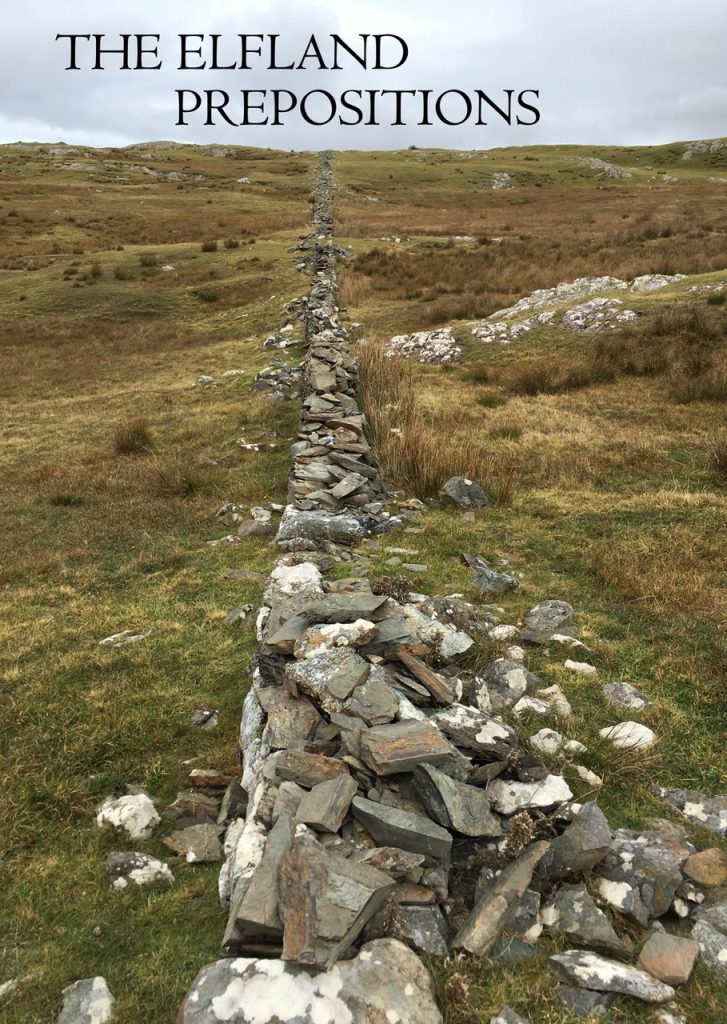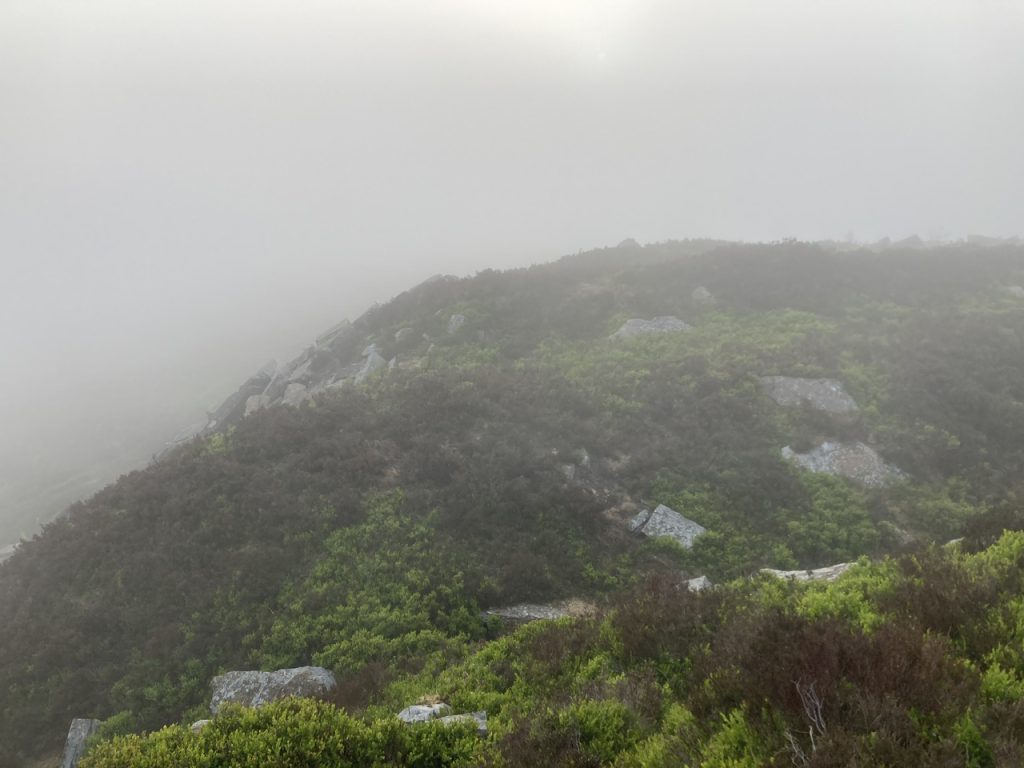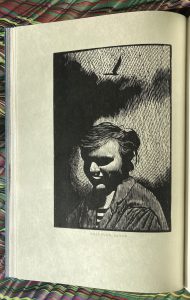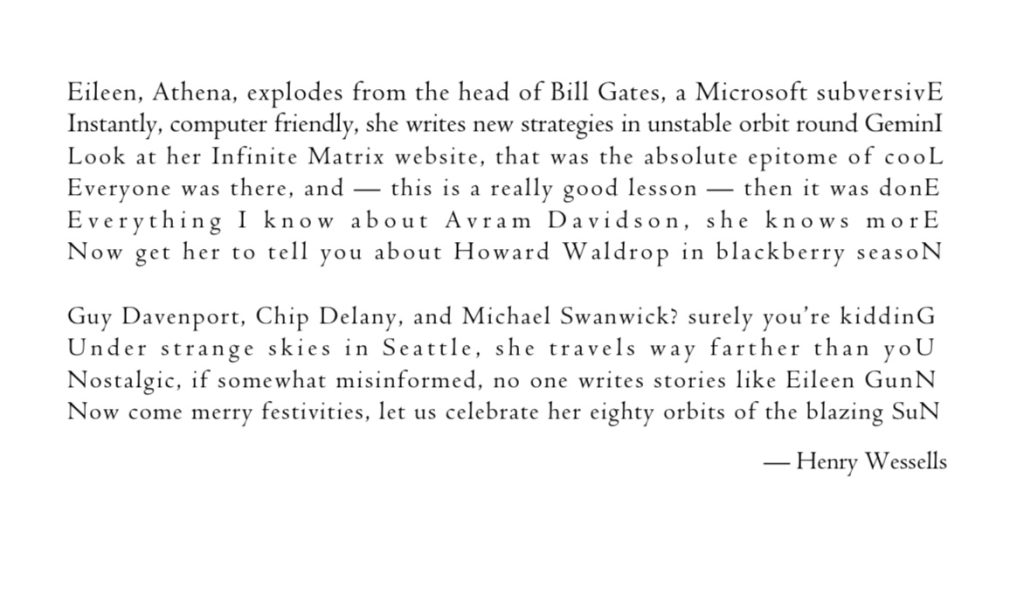
Author: Henry Wessells
recent reading : june 2025
recent reading : early june
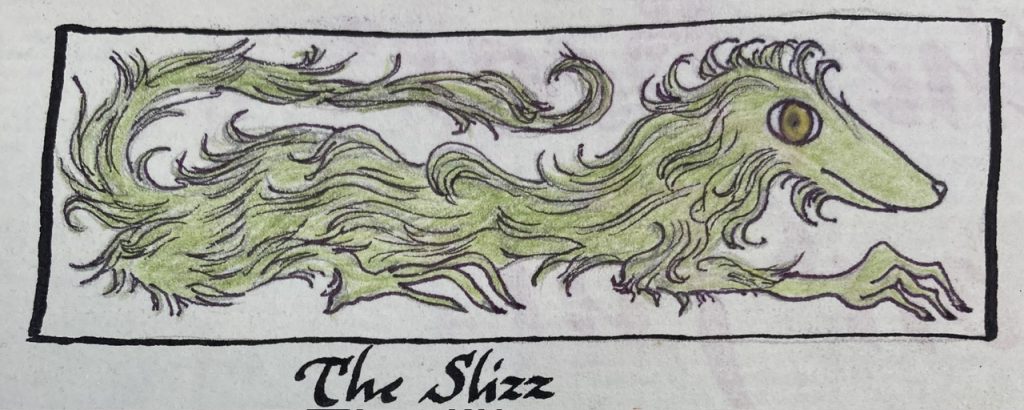
— Tom LaFarge. The Crimson Bears. Part I. Sun & Moon Press, [1993].
——. A Hundred Doors. The Crimson Bears. Part II. Sun & Moon Press, [1994, i.e., 1995].
/ I have loved The Crimson Bears ever since I first encountered them, I read read them aloud to the offspring, and wrote about them, and about the early career of Tom La Farge (1947-2020) here : https://endlessbookshelf.net/bargeton.html
Am re-reading these in advance of the re-issue by Tough Poets Press. This is fabulous news !
— Paul McAuley. War of the Maps [2020]. VG [Gollancz], 2021.
/ what a writer ! McAuley makes it happen. Everything is otherwise but there are echoes & riffs of Beckett early on, and I see everywhere threads of Le Guin (The Dispossessed, in particular) ; and now, far out in the world ocean, a glimpse by the lucidor protagonist of world wanderers (an albatross by any other name) conjures up all the ripples of Coleridge ; and the deployment of Chekov’s dictum is deft and sudden. McAuley’s unexpected turns are shocking, deeply satisfying, the work of a magician who sets up his effects with precision and perfect timing.
— — —
this just in
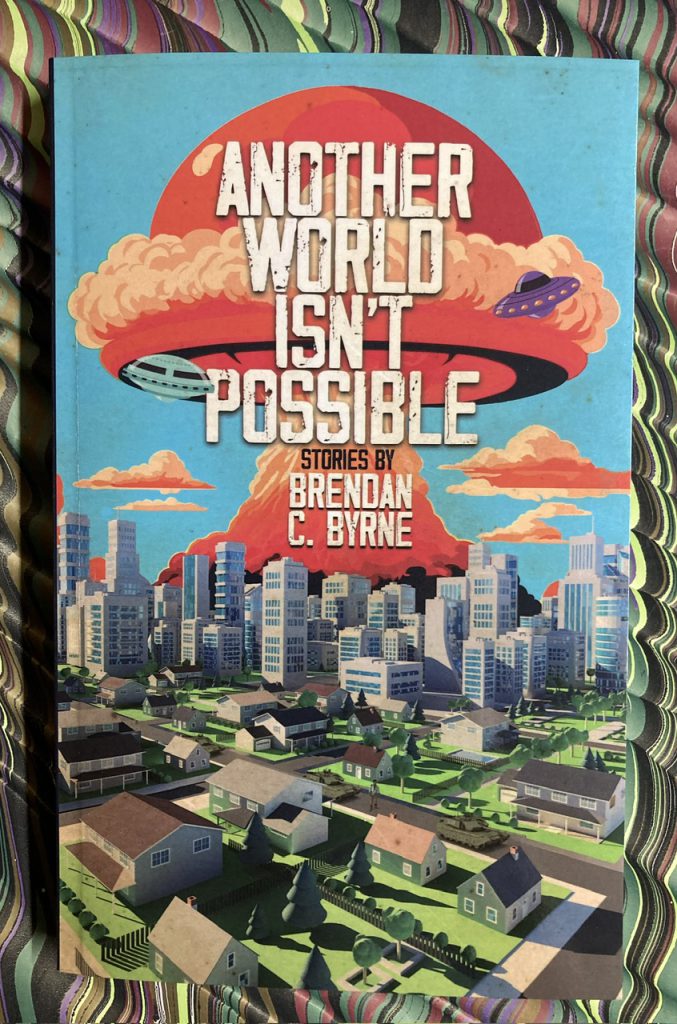
— Brendan C. Byrne. Another World Isn’t Possible. Stories. 226, [4], [6, ads], [3, blank], [1, imprint] pp. [Melbourne :] Wanton Sun, [2025 : POD, Chambersburg, Penna., 5 June]. Cover by Matthew Revert.
/ I know a few of these stories (even published one), but wow ! have I been looking forward to this collection. Stylish design !
/ from the blurbs : “Ruthlessly hip, transreal surreal. Worth your time.” — Rudy Rucker
— — —
various :
— Brian Eno and Bette Adriaanse. What Art Does. An Unfinished Theory [2024]. Faber, [2025].
/ serious, playful thinking about the what and why of art.
/ the Endless Bookshelf reminds readers of the Humument fragment by Tom Phillips, “the reader is the artist” :
https://temporary-culture.com/conversation43e/
— Colin Wilson. Jorge Luis Borges. Cover with portrait drawing by Hugo Manning. London : Village Press, 1974.
/ literary journalism by Colin Wilson, reductive in tone, and in the end more interested in himself than in the writings of Borges
— John Shen Yen Nee and S J Rozan. The Railway Conspiracy. Soho Crime, [2025].
— William S. Reese. The Best of the West. 250 Classic Works of Western Americana. William Reese Company, 2017.
/ succinct illustrated discussion of books (1555-1941) that chart the exploration and settlement of the American West.
— — —
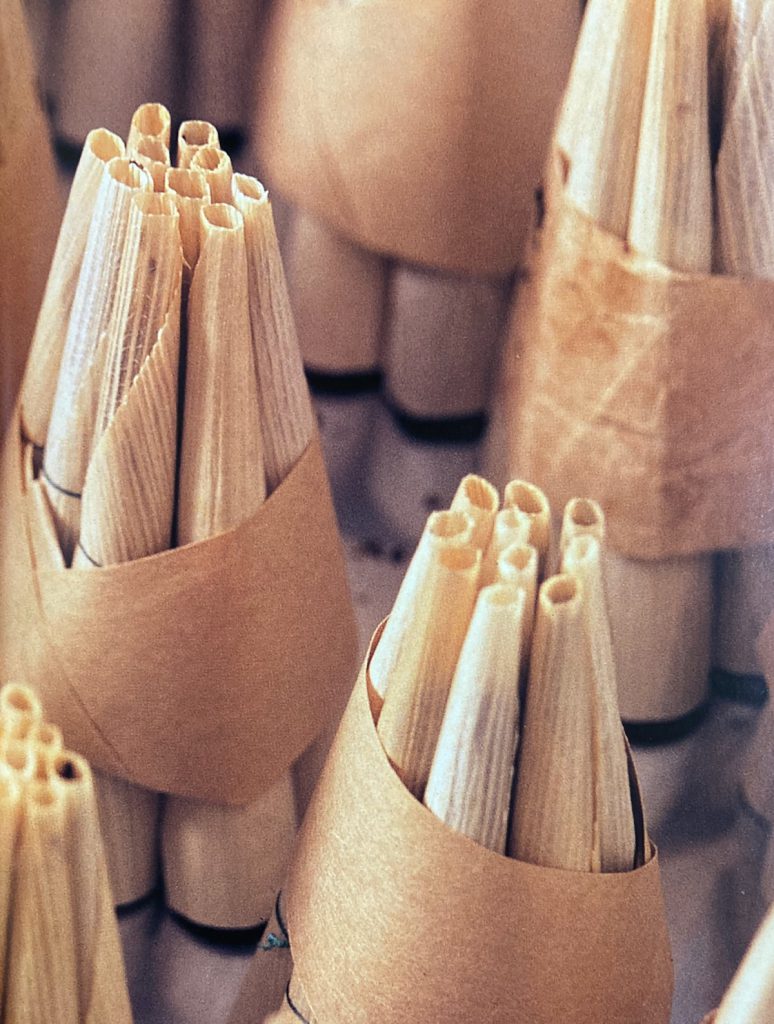
— Mark Hanusz. Kretek. The Culture and Heritage of Indonesia’s Clove Cigarettes. [With a foreword by Pramoedya Ananta Toer]. Illustrated in color throughout. [xx], 203 pp. Equinox Publishing, 2000.
/ heard about this from a new acquaintance who grew up in Indonesia and described the sensory rush of memories arising, years later, from finding a discarded packet of clove cigarettes. Never smoked them myself but the olfactory memory is there. Bought two copies, one for a friend interested in the history of smoking and related phenomena.
— — —
— Heiress. Sargent’s American Portraits. 16 May – 5 October 2025 [Cover title]. [Foreword by Richard Ormond]. English Heritage | Kenwood, 2024.
/ Catalogue of an exhibition of 18 portraits by John Singer Sargent, with summery biographies of the American heiresses who married into the British inner circles and aristocracy. An excellent, compact show. Ormond is author of the Sargent catalogue raisonné.
The Elfland Prepositions by Henry Wessells
— Henry Wessells. The Elfland Prepositions. Temporary Culture, 2025.
Printed on Mohawk superfine white eggshell. Pictorial wrappers. 26 copies, lettered A to Z, were reserved for presentation ; there were also 100 copies numbered 1 to 100. Edition of 326 copies.
Collection of four previously unpublished short stories :
Cleaning up Elfland
The Barmaid from Elfland
John Z. Delorean, Dry Cleaner to the Queen of Elfland
A Detective in Elfland
Published 27 February 2025. Click on link or photo to order.
ISBN13 978-0-9961359-0-0 ISBN 0-9961359-0-1
Elfland is not a nice place, but it’s important to know how it works.
— — —
“elegant” — MICHAEL DIRDA, in the Washington Post
“Here is an Elfland as implacable as ever, but now ruthlessly enmeshed in contemporary mortal affairs.” — MARK VALENTINE
“very clever, beautifully dark in implication. [. . .] Wessells is not prolific at all (in fiction) but what he does is outstanding.” — RICH HORTON
”If you don’t believe in magic, read Henry Wessells and find out how wrong you are.” — GUY DAVENPORT
recent reading : may 2025
recent reading :
— John James Audubon. My Style of Drawing Birds. Introduction by Michael Zinman. The Overland Press for the Haydn Foundation, 1979.
Facsimile and transcription of a fascinating manuscript, “Audubon’s definitive statement on the achievement to which he devoted his life”.
— Arthur Freeman and Janet Ing Freeman. Anatomy of an Auction. Rare Books at Huxley Lodge, 1919. The Book Collector, 1990.
How books were really sold in Britain, once upon a time. Discussion of the “ring” in action at a country house sale, based on documentary evidence of the “knock out” and “settlement” among participating dealers : a Shakespeare First Folio sold for £100 in the room and £1,550 in the third round (with the surviving participants dividing the difference between them). This sort of arrangement was abolished by law in 1927 but continued illegally into the 1950s.
— Frank Baker. Miss Hargreaves. A Fantasy. Eyre and Spottiswoode, 1940.
Bonkers : a poetry hoax, what can possibly go awry ?
— Pramoedya Ananta Toer. All That Is Gone. Translated from the Indonesian by Willem Samuels. Hyperion East, [2004].
Short stories ranging in time from the colonial period through the Japanese occupation and early independence. The title story is episodic and invokes the transitory nature of things.
— — —
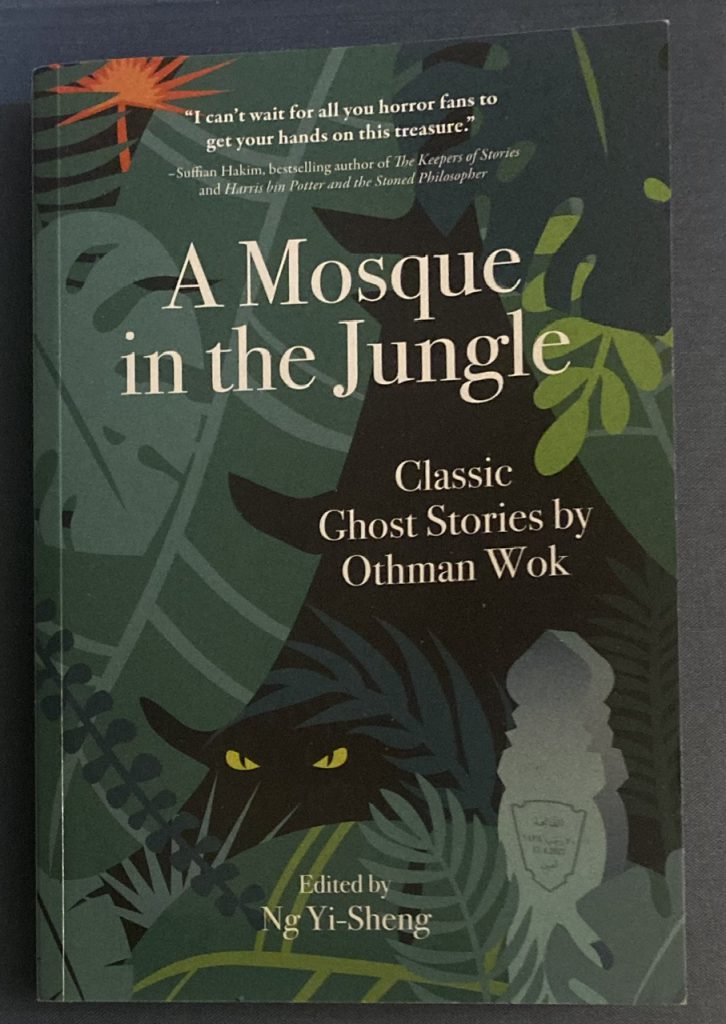
— Othman Wok. A Mosque in the Jungle. Classic Stories . . . . Edited by Ng Yi-Sheng, with translations by M M Basalamah and Tan Poay Lim. Epigram, [2021].
— Clarence Wolf. Fifty Years a Bookseller or, The Wolf at Your Door. Second, expanded edition. Privately printed, 2025.
/ the first edition (2022) vaulted right into the top five bookshop memoirs (joining the ranks of Tim d’Arch Smith’s The Times Deceas’d and Not 84 Charing Cross Road by Driffield, and two others where I will concede there is room for debate) ; the new edition adds more anecdotes and an index. Outstanding and witty !
— — —
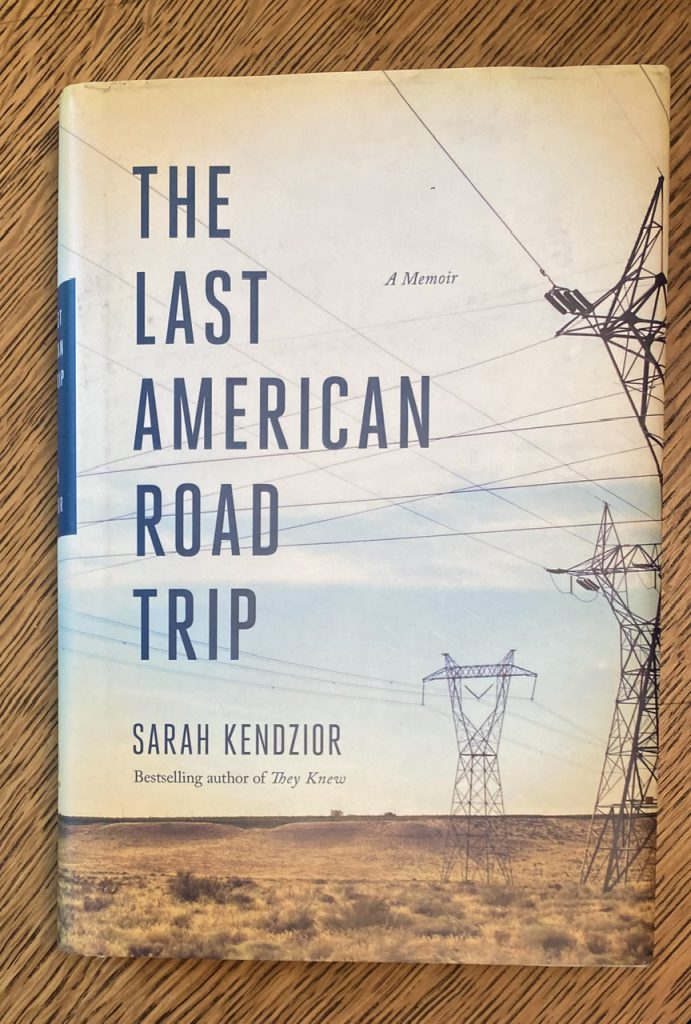
‘not our family’s first float trip through an abandoned mine’
— Sarah Kendzior. The Last American Road Trip. Flatiron Books, [2025].
Well written and intensely engaging book, family travels in an uncertain America. Kendzior is direct and unflinching and honest. She has travelled to some remarkable places in what the French would call “l’Amérique profonde”, deep in the heart of the heart of the country. Kendzior is brave and funny and clear-eyed about America in our time.
— Bjørn Berge. Nowherelands. An Atlas of Vanished Countries 1840-1975. [Translated from the original Norwegian by Lucy Moffatt]. Thames & Hudson, [2017].
An excellent travel book to odd corners of the globe, anchored by postage stamps and illuminated by literary citations. I wondered at the omission of one small country until I saw the date of the extinction of Biafra in the original title, Landene som forsvant, 1840-1970 (Countries that vanished ?), which answers the question. Of the fifty, more than a dozen were unknown to me, and another six or seven only as names on a map. This book made me think of The World of Donald Evans ; and Secret Europe by John Howard and Mark Valentine (2012), who re-write the imaginative geography of continental Europe in the interwar years* in a gorgeous book fragrant with “that air of mystery, transgression, and foreboding” identified by Michael Dirda.
——
* and in the perpetual life during wartime all years past now seem interwar years
— — —
— John Scalzi. Old Man’s War [2005]. [With a new introduction]. Tor, [2024].
— Ian Rankin. Midnight and Blue. An Inspector Rebus Novel. Mulholland Books, [2024].
commonplace book : may 2025
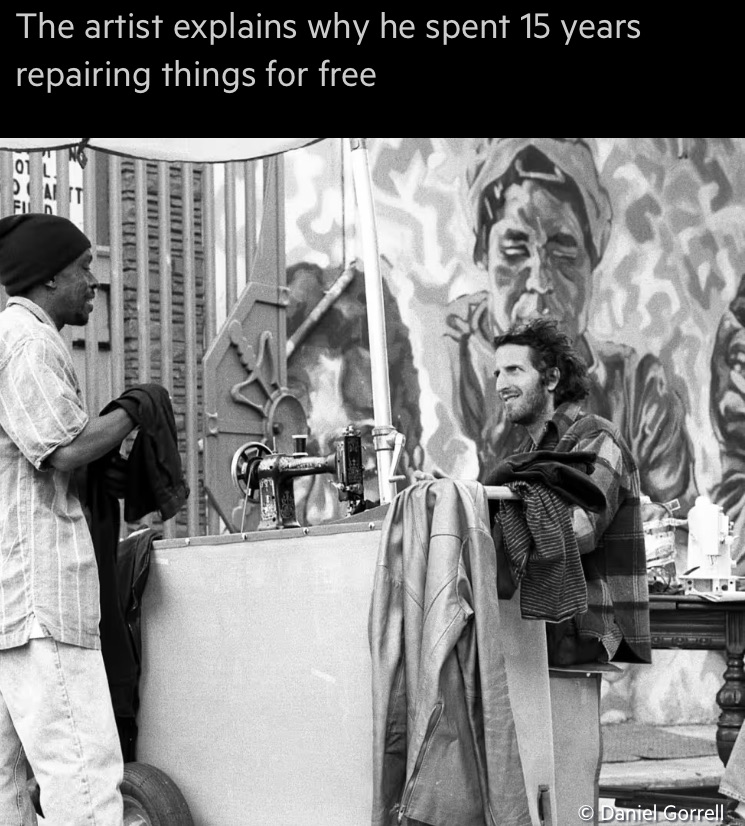
Michael Swaine : ‘What I learnt from mending strangers’ clothes’ / in the FT glossy magazine HTSI
Readers of the ’shelf will recall Michael Swaine as one of the impresarios of the Weedwalk : Book Walk in its two iterations in 2007 and 2009 . Only here will you read about the skill of bookshoeing :
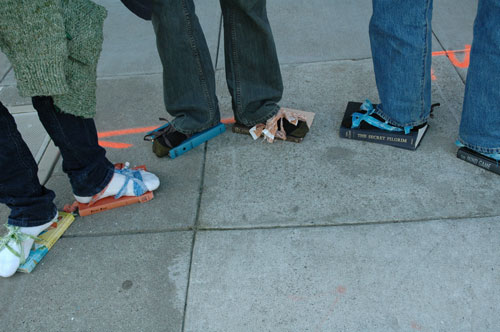
— — —
Your correspondent will be in London for the Firsts Book Fair, from 15 to 18 May, in the Saatchi Gallery, Duke of York’s Square, King’s Road, London SW3 4RY (at the Cummins booth C21). Come say hello.
This means that, for the first time in many years, your correspondent will not be on hand for that glorious annual manifestation of impermanence, Rhododendron Day, which will occur earlier this year. Here is a snap of the work in progress, earlier today : the blooms opened further during the warm day
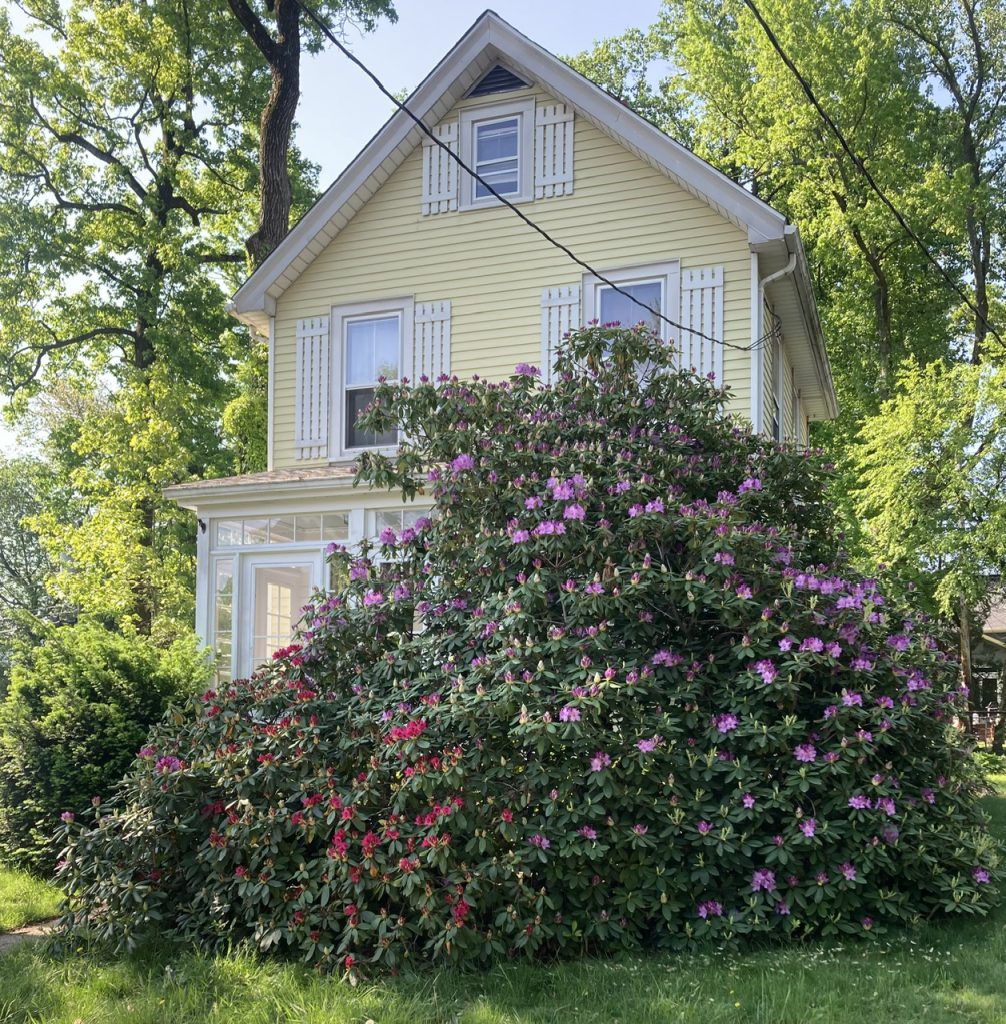
— — —
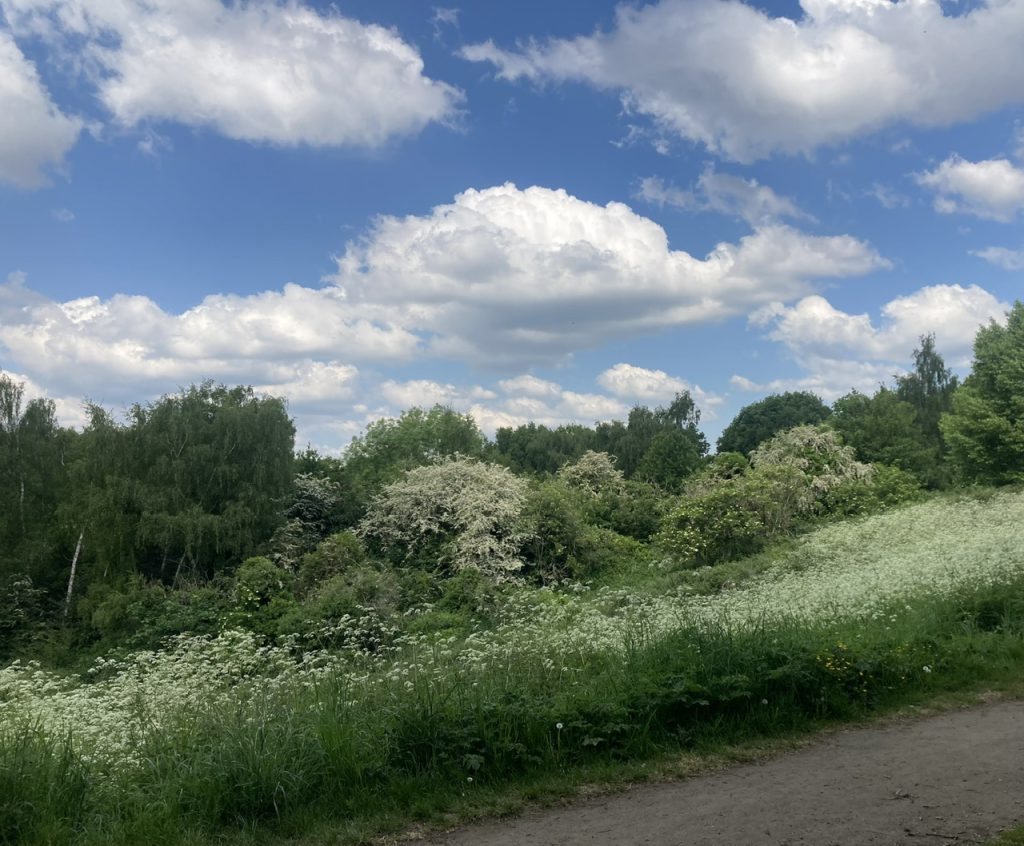
Hampstead
— — —
above Haworth, shortly after dawn, 21 May
A Book of Ryhmes by Charlotte Brontë
Forthcoming 21 April 2025 from Tartarus Press in association with the Brontë Society :
The first publication of A BOOK OF RYHMES by Charlotte Brontë reproduces her handwritten pages in facsimile at original size, as well as enlarged, alongside a transcription of the poems. The book includes an Introduction by Patti Smith, and essays by Barbara Heritage and Henry Wessells. The book will be available in hardcover and paperback.
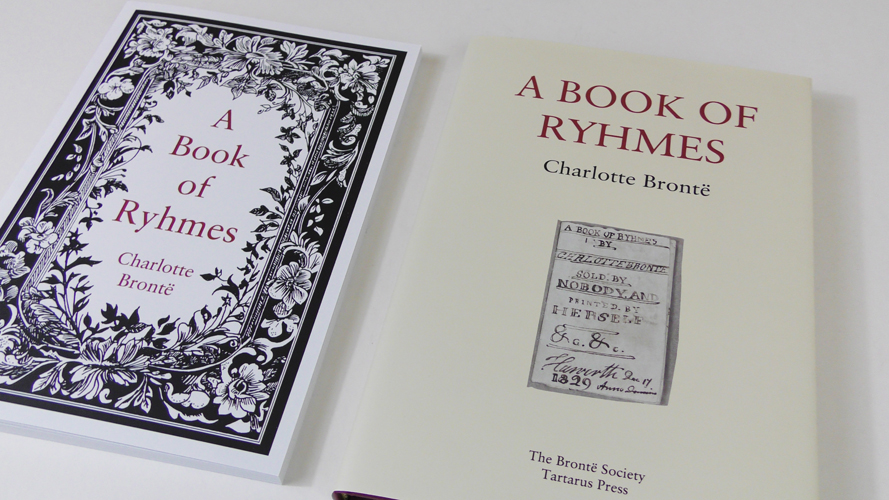
Details and advance order information here :
http://tartaruspress.com/bronte-a-book-of-ryhmes.html
The manuscript book of verse was composed by Charlotte Brontë in the autumn of 1829. It was known to her biographer, Mrs. Gaskell, and had last been sighted in 1916. Readers of the Endless Bookshelf will recall the reappearance of the manuscript at the New York Book Fair on 21 April 2022, and its sale to the UK charity, Friends of National Libraries for donation to the Brontë Parsonage Museum in Haworth. And now everyone can read Charlotte’s Ryhmes.
Note added 5 April : your correspondent is a bit giddy with happiness, pictured here holding the first copy of A BOOK OF RYHMES in New York City.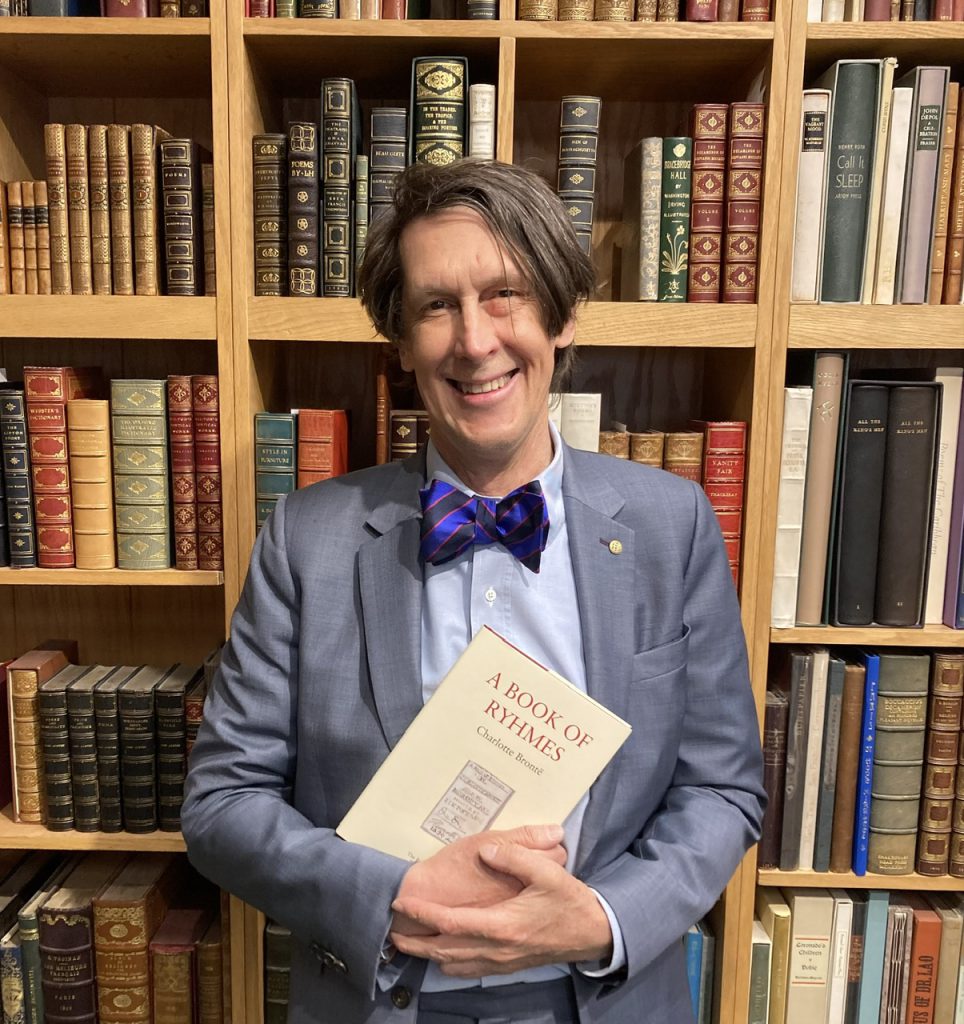
commonplace book : march 2025
31 March current reading :
— Winsor McCay. The Complete Little Nemo 1905-1927. / Alexander Braun. Winsor McCay A Life of Imaginative Genius [2014]. Taschen, [2022].
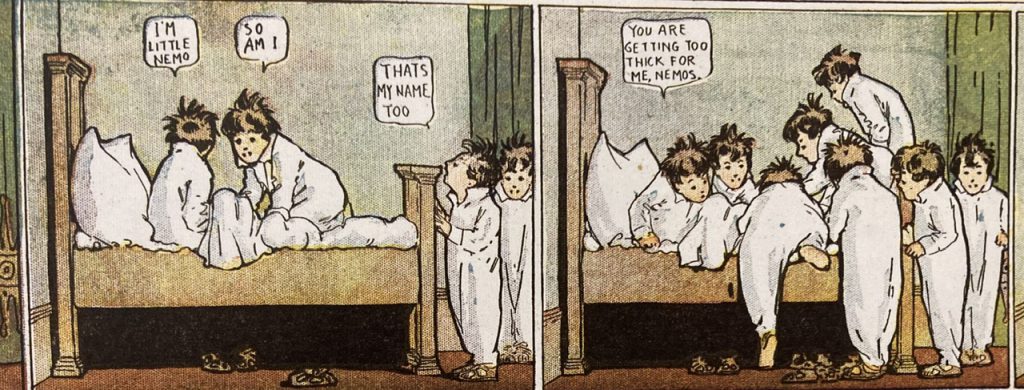
— — —
— Raphael Cormack. Holy Men of the Electromagnetic Age. A Forgotten History of the Occult. W. W. Norton, [2025].
— — —
26 March / homeward bound
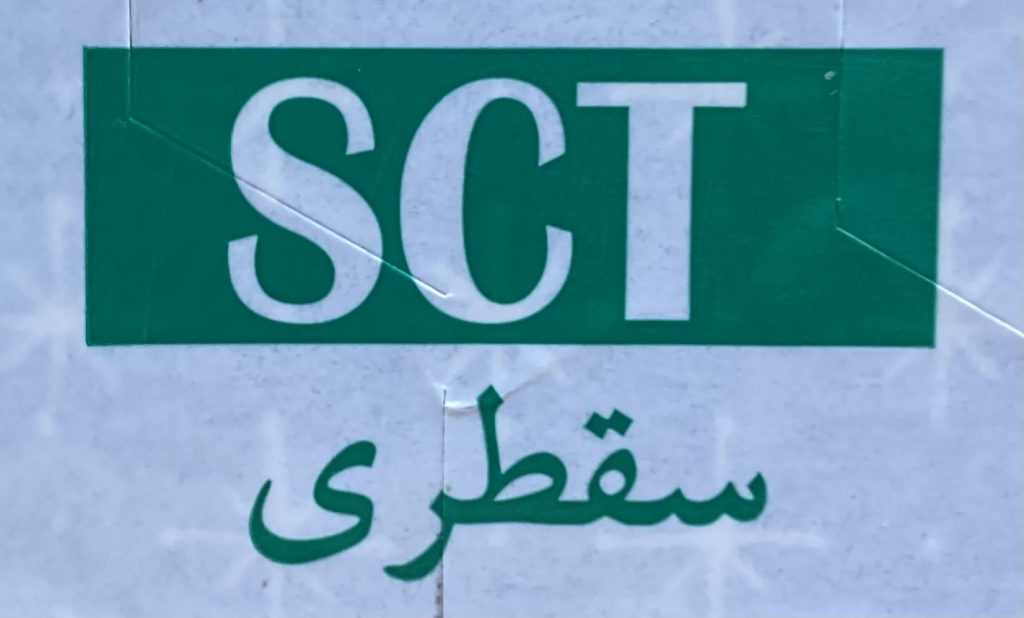
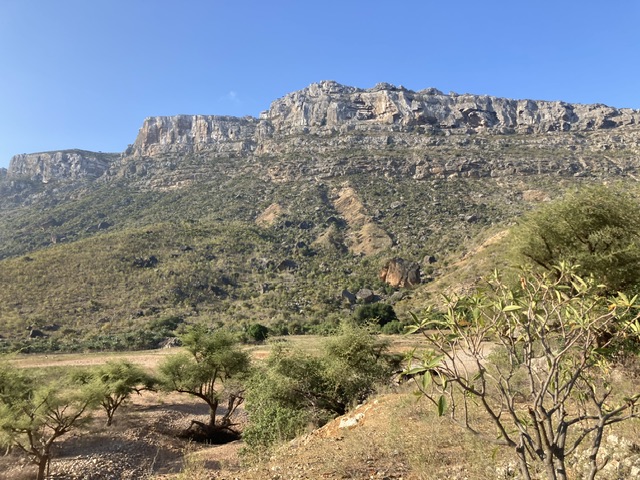
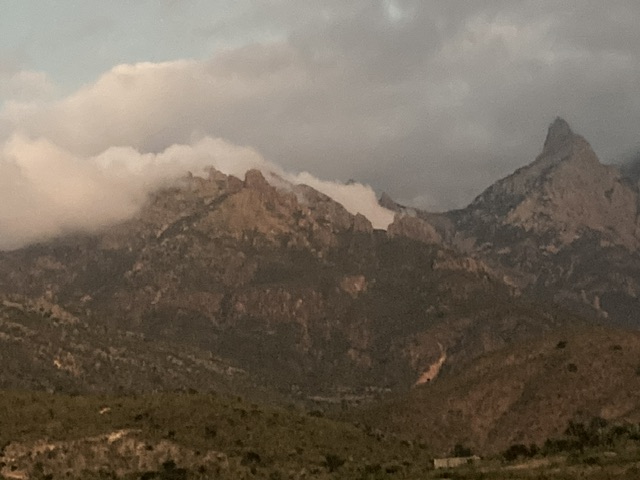
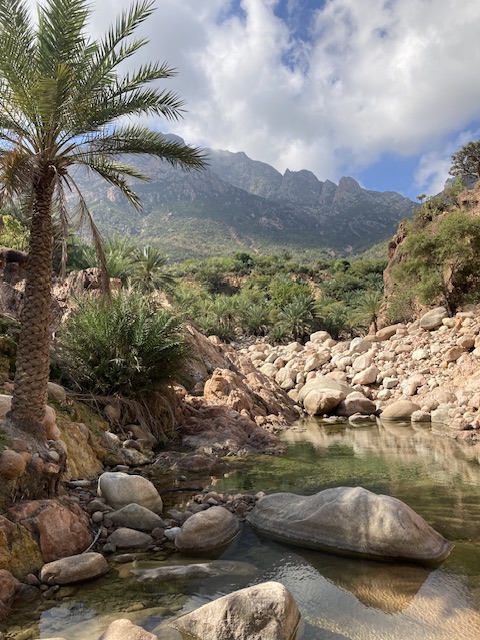
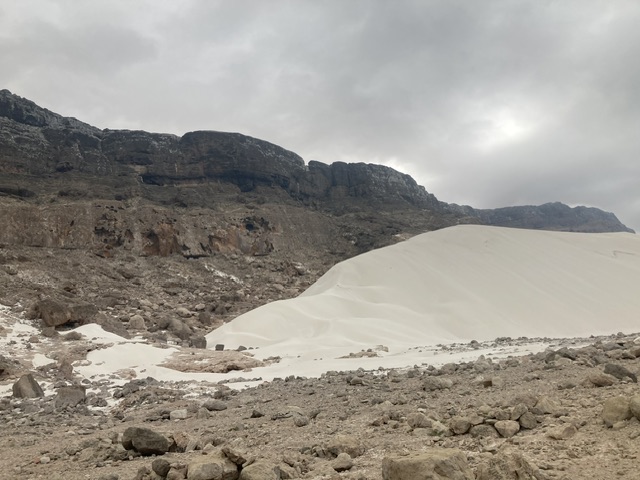
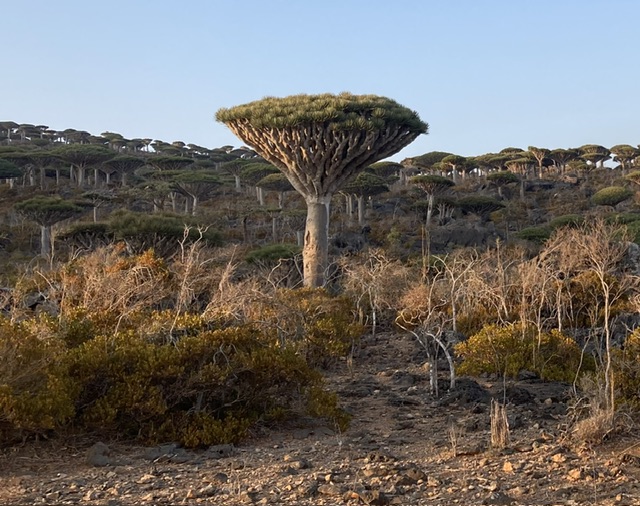
— — —
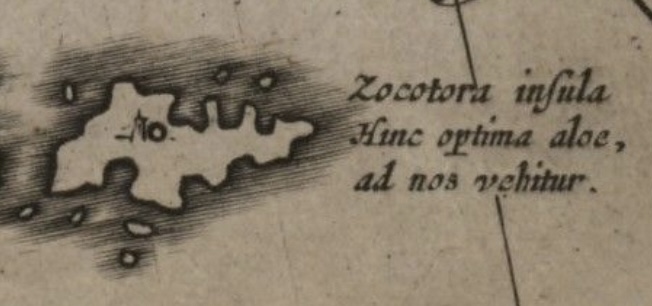
Your correspondent will be far away, and farther, and off line for the next couple of weeks, and will report upon re-entry. [Image above, Zocotora insula, detail from Turcicum imperium, in a Blaeu atlas at the Beinecke.]
Looking ahead to April, the Brontë Society and Tartarus Press will be publishing A Book of Ryhmes by Charlotte Brontë, the manuscript book from 1829 now at the Brontë Parsonage Museum, in a fully illustrated edition with an introduction by Patti Smith, a scholarly essay by Barbara Heritage, and an afterword by Henry Wessells. Publication is scheduled for 21 April (birthday of Charlotte Brontë) and further details will be available at http://tartaruspress.com/bronte-a-book-of-ryhmes.html.
Also in April, the New York Antiquarian Book Fair will be held 3-6 April at the Park Avenue Armory. Come say hello (Cummins booth A3).
— — —
recent reading :
— John Crowley. Little, Big [1981]. Harper Perennial paperback.
Just felt like re-reading it, again.
[added note : an old and trusted friend, carried to the end of the world and back ; always something new arises from the experience of reading Little, Big]
— — —
William Morris on the shelves at Chenati
The library of Donald Judd at at La Mansana de Chinati/The Block in Marfa, Texas, has been catalogued in a neat interactive (and searchable) display. When we visited back in May 2015, I remember being struck by the extent of Judd’s holdings of another artist polymath, William Morris ; the detail above shows most of those holdings. [Thanks to CB for the link.]
https://library.juddfoundation.org/#about
— — —
recent reading :
— Walter Abish. 99 : The New Meaning. With photographs by Cecile Abish. Burning Deck, [1990].
The few books I have published, however, won me no fame. I do not complain of this, anymore than I brag of it, for I feel the same distaste for the “popular author” genre as for that of the “neglected poet” (from “What Else”)
— Philip K. Dick. Radio Free Albemuth [1985]. Mariner pbk. [printed 29 Jan. 2025].
/ re-reading, though I have been thinking about “the tyranny of Ferris F. Fremont” for some time, indeed for much of the past decade
— Peter Straub and Anthony Discenza. “Beyond the Veil of Vision : Reinhold von Kreitz and the Das Beben Movement” [in:] Conjunctions 65, 2015.
— Mark D. Tomasko. Wish You Were Here. Guidebooks, Viewbooks, Photobooks, and Maps of New York City, 1807-1940, from the collection of Mark D. Tomasko. Grolier Club, 2025.
Illustrated catalogue for an exhibition on view through 10 May 2025. The Viele Topographical Map (1865) displays all the watercourses and terrain of Manhattan before the city became part of the built environment.
— — —
commonplace book :
“Elfland as implacable as ever, but now ruthlessly enmeshed in contemporary mortal affairs.” — Mark Valentine, at Wormwoodiana
https://wormwoodiana.blogspot.com/2025/03/henry-wessells-elfland-propositions.html
— — —
books received :
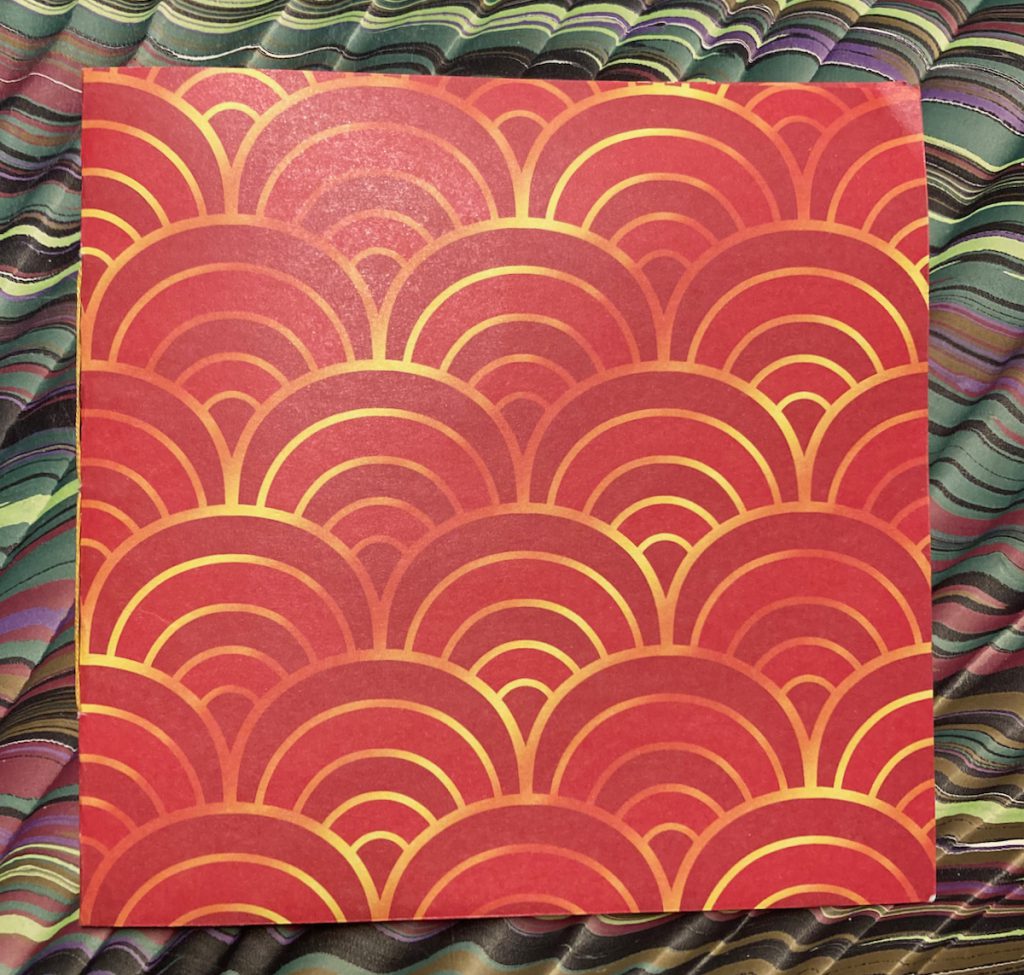
— Michael Swanwick. A Fantasist’s Guide to Venice. Dragonstairs Press, 2025. Edition of 79.
Collection of nine anecdotes about Venice, life and death, and writing, by the author of “The Mask” (collected in Tales of Old Earth).
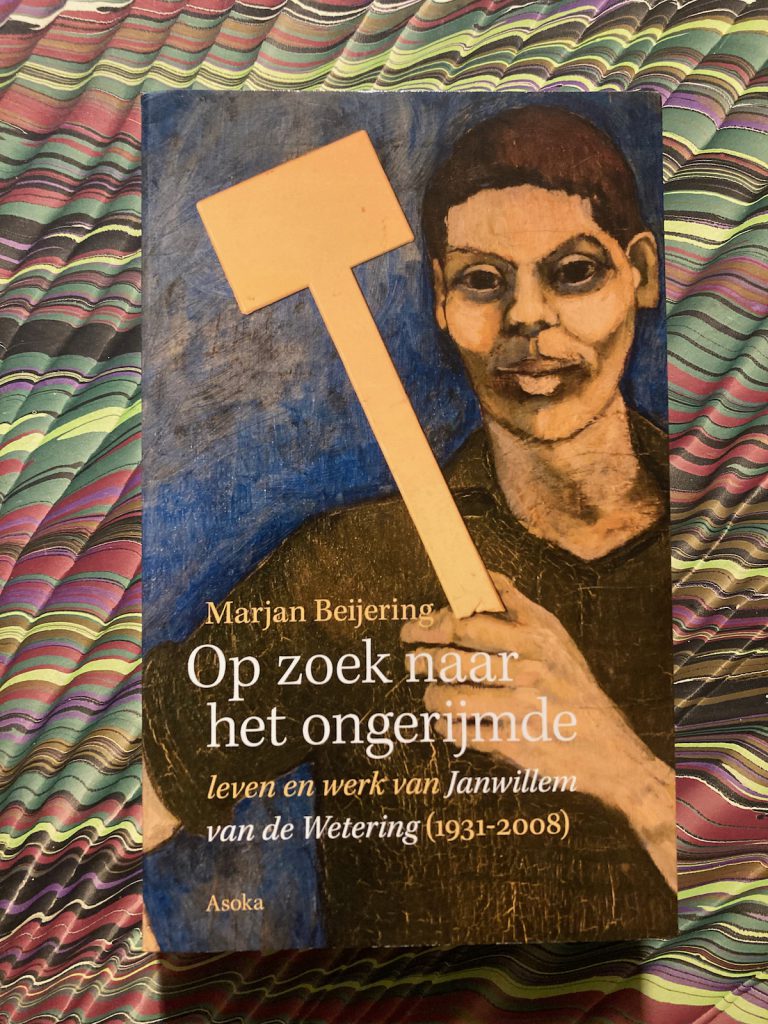
— Marjan Beijering. Op zoek naar het ongerijmde. Leven en werk van Janwillem van de Wetering (1931-2008). Asoka, [2021].
— — —
‘we are a verb, not a noun’
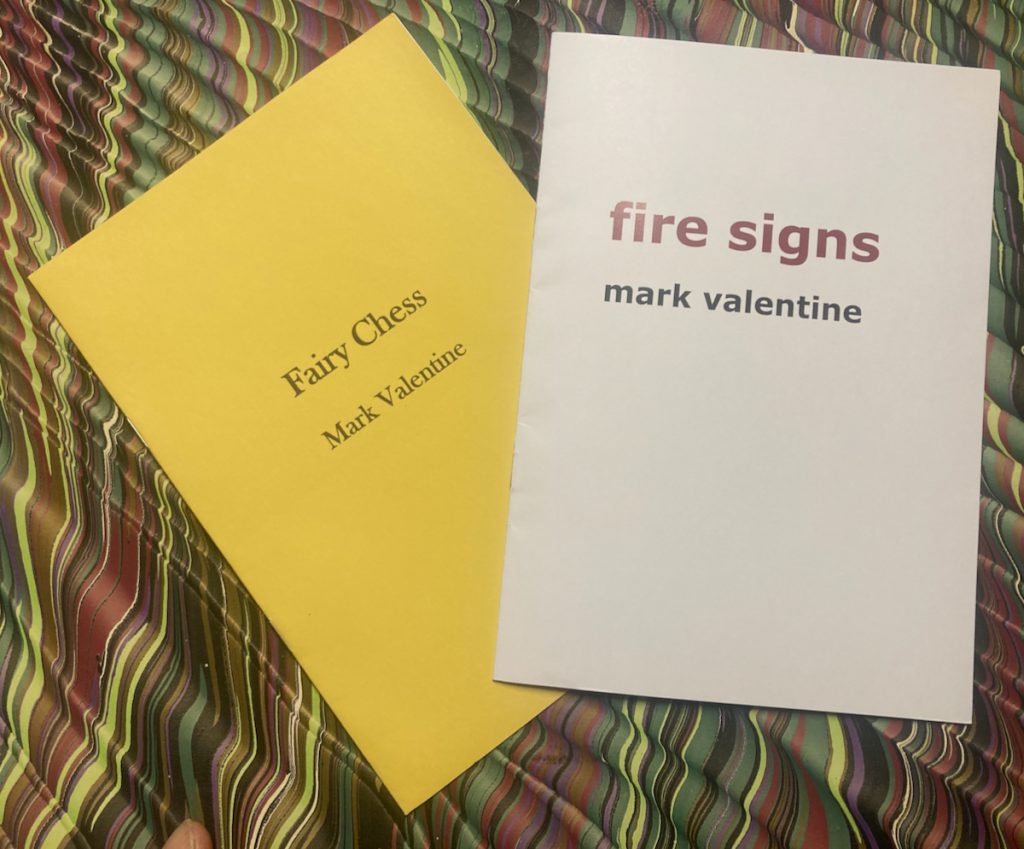
— Mark Valentine. Fairy Chess [cover title]. 2025. Edition of 100.
Collects five poems written in response to words or phrases in the work of Veronica Forrest-Thompson, with allusions to Wittgenstein, Gauloises, libraries, and bicycles.
— —. Fire Signs. [cover title]. 2025. Edition of 100.
Visual record of found poetry from Sunny Bank Mill, Farsley near Leeds.
commonplace book : february 2025
The Elfland Prepositions, published 27 February
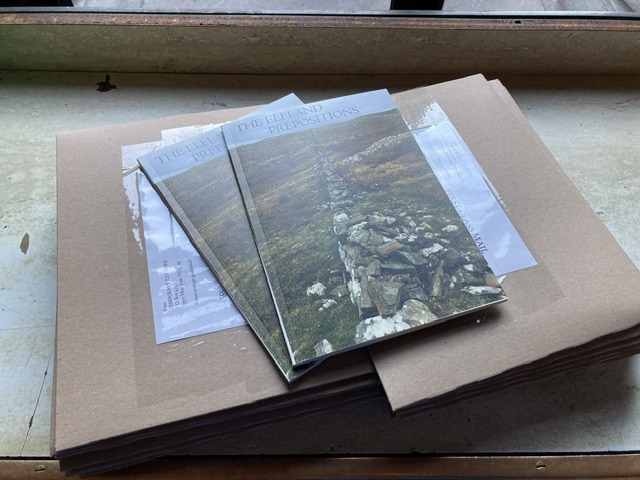
advance presentation copies, at the post office ready for mailing [26 February]
—
in production
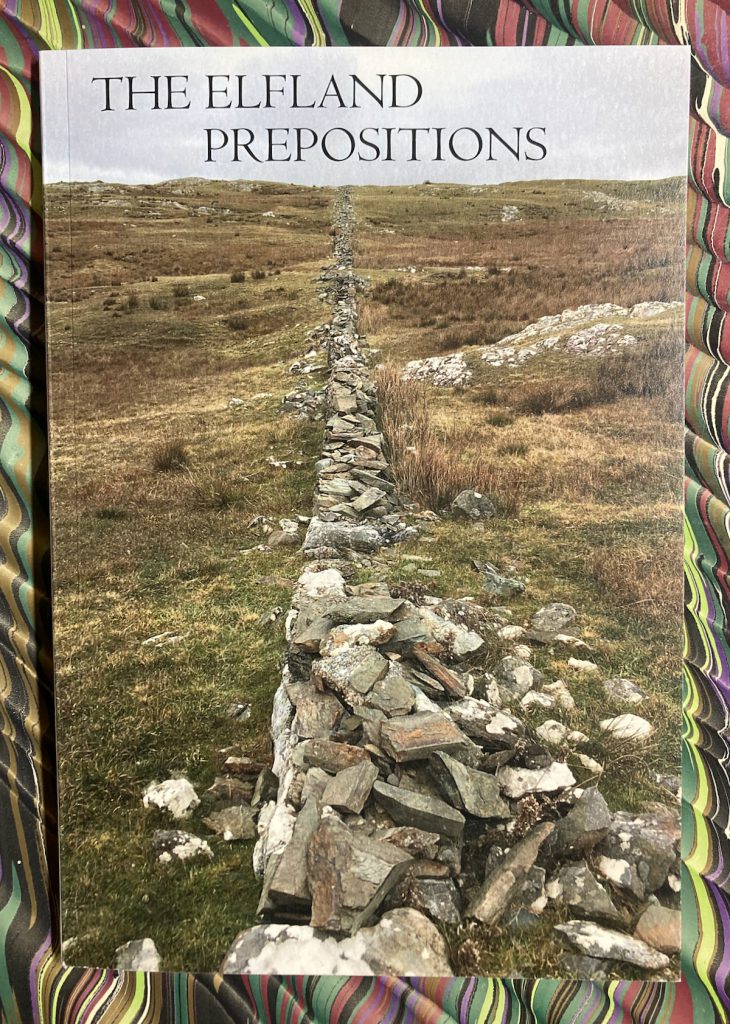
— Henry Wessells. The Elfland Prepositions. Temporary Culture, 2025.
Printed on Mohawk superfine white eggshell. Pictorial wrappers. 26 copies, lettered A to Z, were reserved for presentation ; there were also 100 copies numbered 1 to 100.
Proof copy above (received 12 February 2025) ; proofs corrected & in production (14 February 2025), published 27 February 2025.
Copies now offered for sale, click on link or photo to order.
ISBN13 978-0-9764660-0-0 ISBN 0-9764660-0-1
Collection of four previously unpublished short stories.
Elfland is not a nice place, but it’s important to know how it works.
— — —
seen in the imagination, and at the Grolier Club :
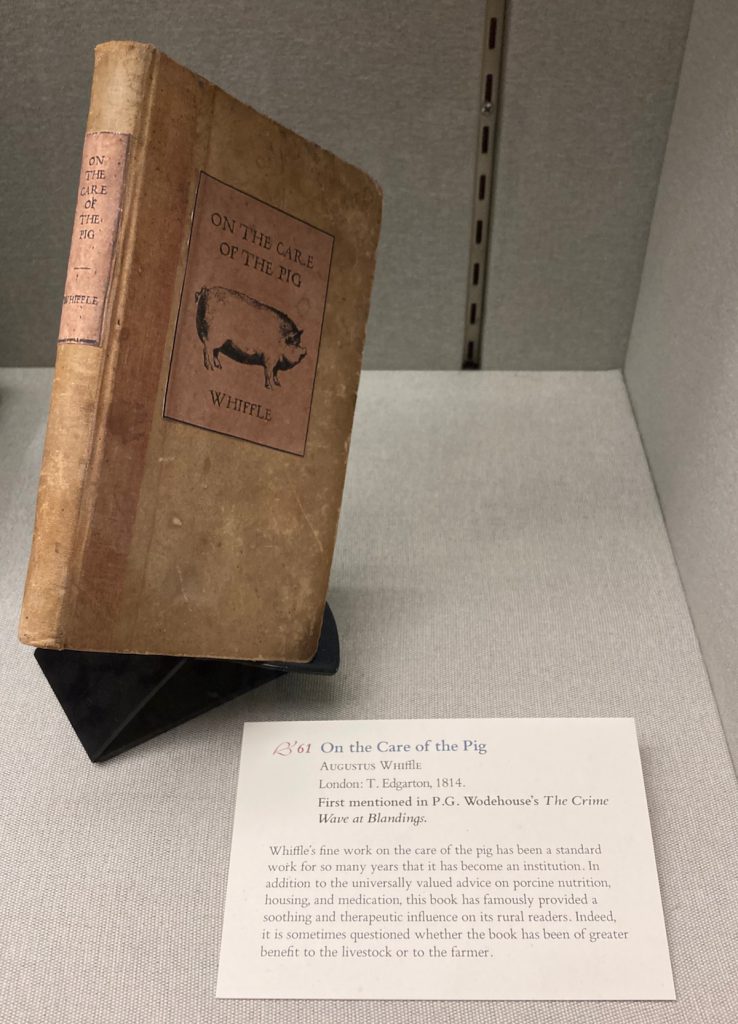
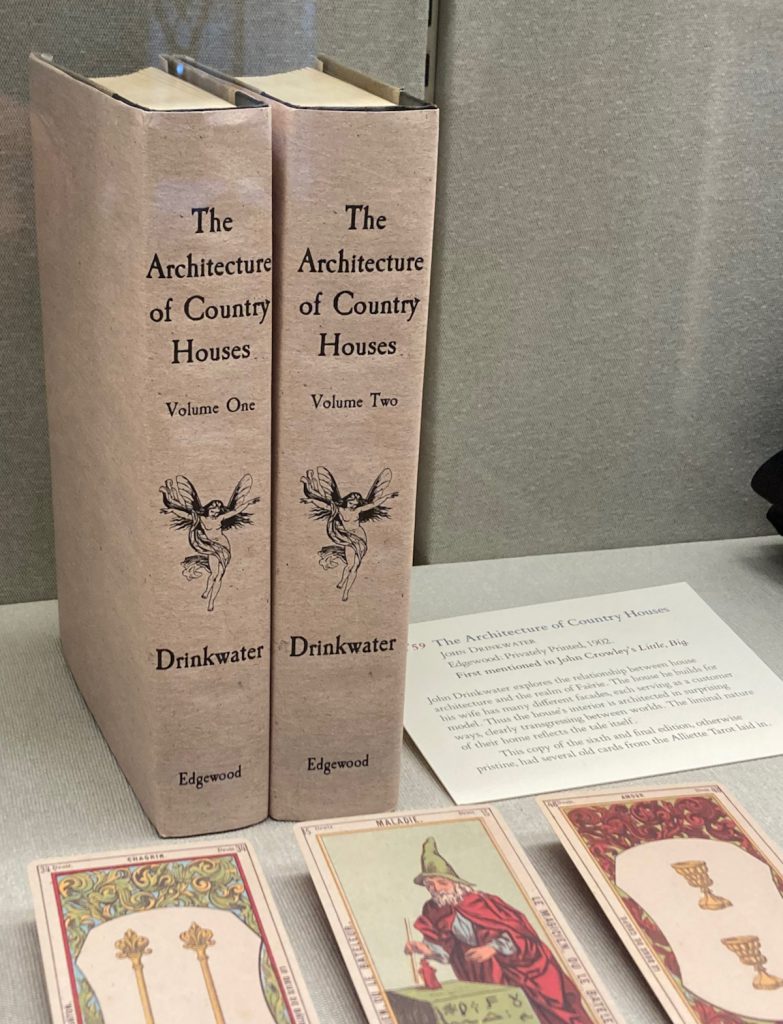
two entries from the recent Grolier Club exhibition, Imaginary Books. Lost, Unfinished, and Fictive Works Found Only in Other Books, from the collection of Reid Byers.
— — —
current reading
— Charles Robert Maturin. Melmoth the Wanderer: A Tale [1820]. With introduction and notes by Victor Sage. Penguin Books, [2000].
/ into the labyrinth, again
— — —
recent reading
— Len Deighton. Hope. HarperCollins, [1995].
— — Charity. HarperCollins, [1996].
— — Winter. A Novel of a Berlin Family. Knopf, 1987.
Germany in the world, 1899-1945 ; back story or bedrock for the Bernard Samson novels.
— — —
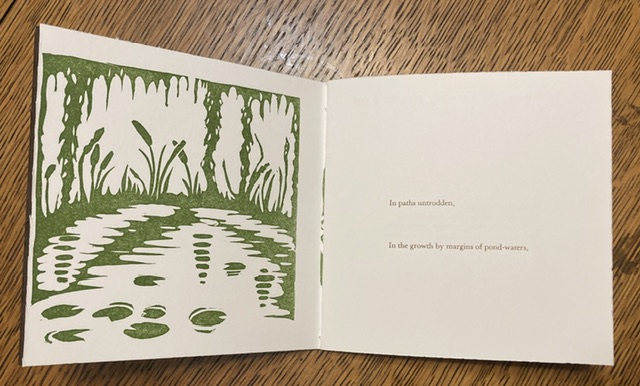
‘away from the clank of the world’
— Walt Whitman. In Paths Untrodden. Printed in brown ink, blockprint illustrations in green and blue. [16] pp. [The Letterpress at Oberlin, January 2025]. Edition of 217.
Calamus 1, from the 1860 Leaves of Grass, with blue herons and green marsh plants. [Gift of VH].
— — —
Hard Rain
by Janwillem van de Wetering
A short note now up (in English) on the excellent and informative Dutch site
https://janwillemvandewetering.nl/favoriete-boek/
— — —
“not relics of the past, but pockets of the future arriving ahead of schedule”
— Christopher Brown, over at The Clearing (the blog of Little Toller Books)
— — —
“When I look at that obscure but gorgeous prose-composition, the Urn-burial, I seem to myself to look into a deep abyss, at the bottom of which are hid pearls and rich treasure ; or it is like a stately labyrinth of doubt and withering speculation, and I would invoke the spirit of the author to lead me through it.”
— Charles Lamb on Sir Thomas Browne, quoted by Hazlitt, in “Of Persons One Would Wish to Have Seen” (1826)
— — —
commonplace book : january 2025
31 January 2025
in today’s mail
— Conjunctions 83. Revenants : The Ghost Issue. Edited by Bradford Morrow and Joyce Carol Oates. Bard College, 2024.
a big issue, with “An Incident in Monte Carlo”, a fragment or outtake from the forthcoming Wreckage by Peter Straub, new work by Elizabeth Hand, James Morrow, Timothy J. Jarvis, Mark Valentine, Reggie Oliver, and many others.
“Fern’s Room” by Liz Hand is pitch perfect, deftly moving from a gentle rom-com American anglophile country house idyll to a very dark endgame, with clues scattered all along the way.
“Plunged in the Years” by Jeffrey Ford, with a few steps off the path in the woods, gets right to the heart of the American ghost story : time and memory (and childhood).
— — —
recent reading
— Len Deighton. Faith [1994]. Grove Press, [2024].
— Margery Allingham. Sweet Danger [1933]. Penguin Books, [1963].
— Nathan Ballingrud. Crypt of the Moon Spider. Nightfire, [2024].
— Avram Davidson. The Adventures of Doctor Eszterhazy. Owlswick Press, 1990.
— — —
books wait for their readers
All antiquarian booksellers have a shelf of what Bill Reese called ‘intractables’ : things that sit on a shelf and seem unsaleable, or just beyond the grasp of one’s understanding, or, indeed, actively resist the efforts of the cataloguer with what M. R. James called the ‘malice of inanimate objects’. And then, suddenly, one finds a new perspective, or works with someone who has the key, and the door unlocks. I am fortunate to have experienced this a few times in my career. To watch this phenomenon in real time is one of the delights of the profession.
The question of whether or not books wait for their writers is trickier to answer. This is a questionof a different order. I would say yes, on balance, but one feels the clock ticking, and the list of books not written is very long.
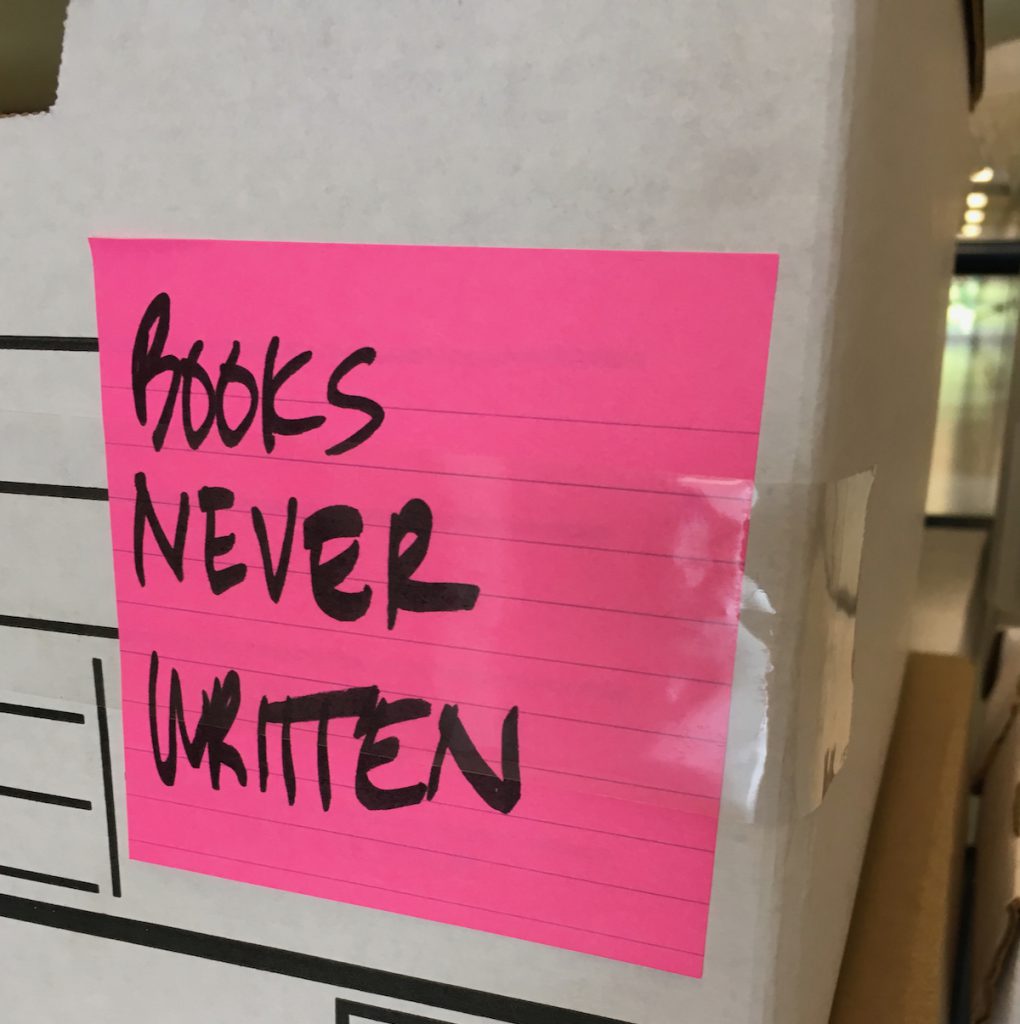
— — —
‘to escape the straitjacket that had been science fiction’ — Paul Kincaid
an excellent essay by a clear-eyed critic ringing the changes on Harlan Ellison’s Dangerous Visions anthologies then and now :
http://strangehorizons.com/non-fiction/who-is-in-danger/
— — —
Eighteen Years of the Endless Bookshelf
Last week marked eighteen years of ‘simply messing around in books’ and reporting the pleasures on this website. It is still fun and so I will continue to note interesting books, curious passages, announcements, occasional snapshots, and digressions.
— — —
an Endless Bookshelf quiz
Who is the Widmerpool ?
— from your year(s) at school or university
— of your chosen field or profession
— observed recurringly elsewhere
/ wrong answers accepted
/ bonus points for naming your favorite book in ‘A Dance to the Music of Time’
— — —
4 January 2025
early in January, and it is already a good year in books, having just received two long-awaited titles in this week’s mailbag
Billy Budd at 100 (continued)
— Herman Melville. Billy Budd. A Centennial Edition with Fourteen Illustrations Cut in Wood by Barry Moser. Pennyroyal Press, 2024. Edition of 50 copies signed by the artist.
A spectacular new large format edition of Billy Budd Sailor (An Inside Narrative) — as the half-title names the book. The text of the novella is set from the Melville Electronic Library, with original woodcuts by American master Barry Moser.
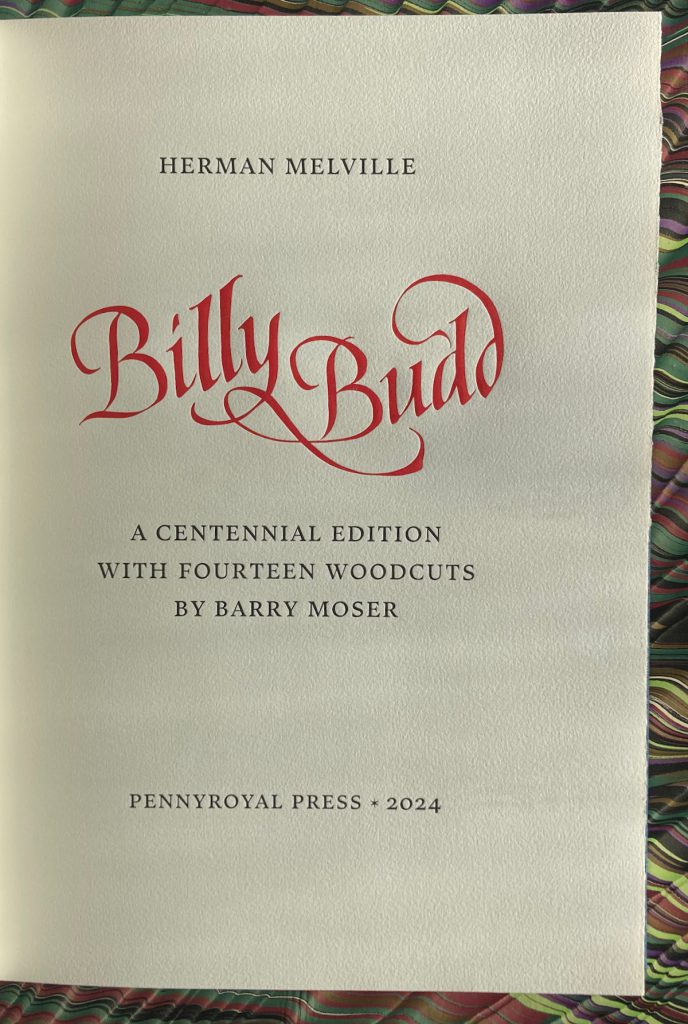
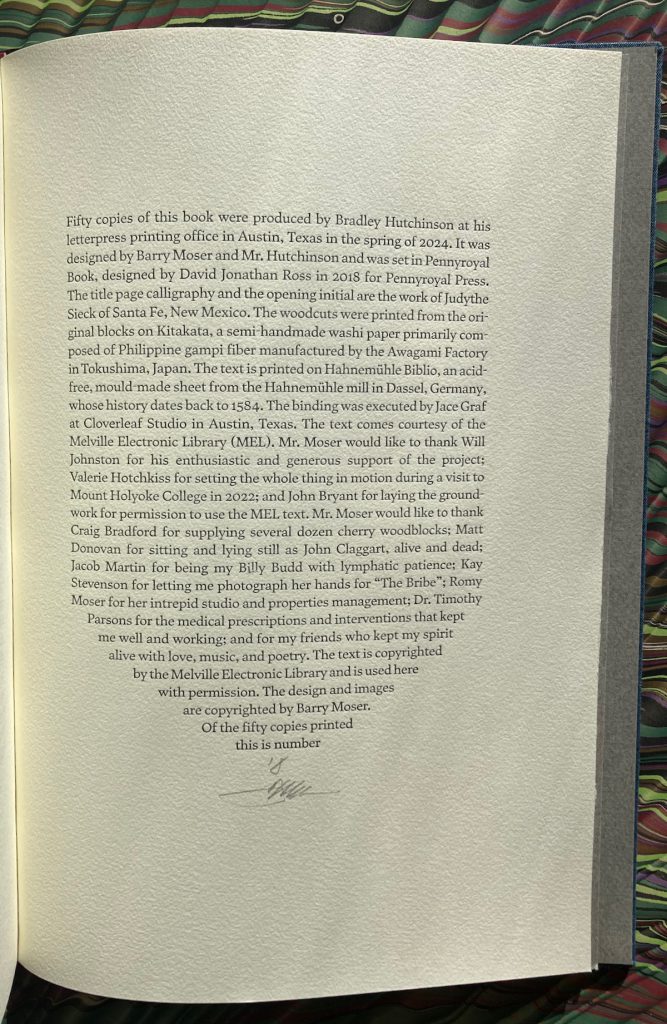
— — —
a Tim Young trifecta
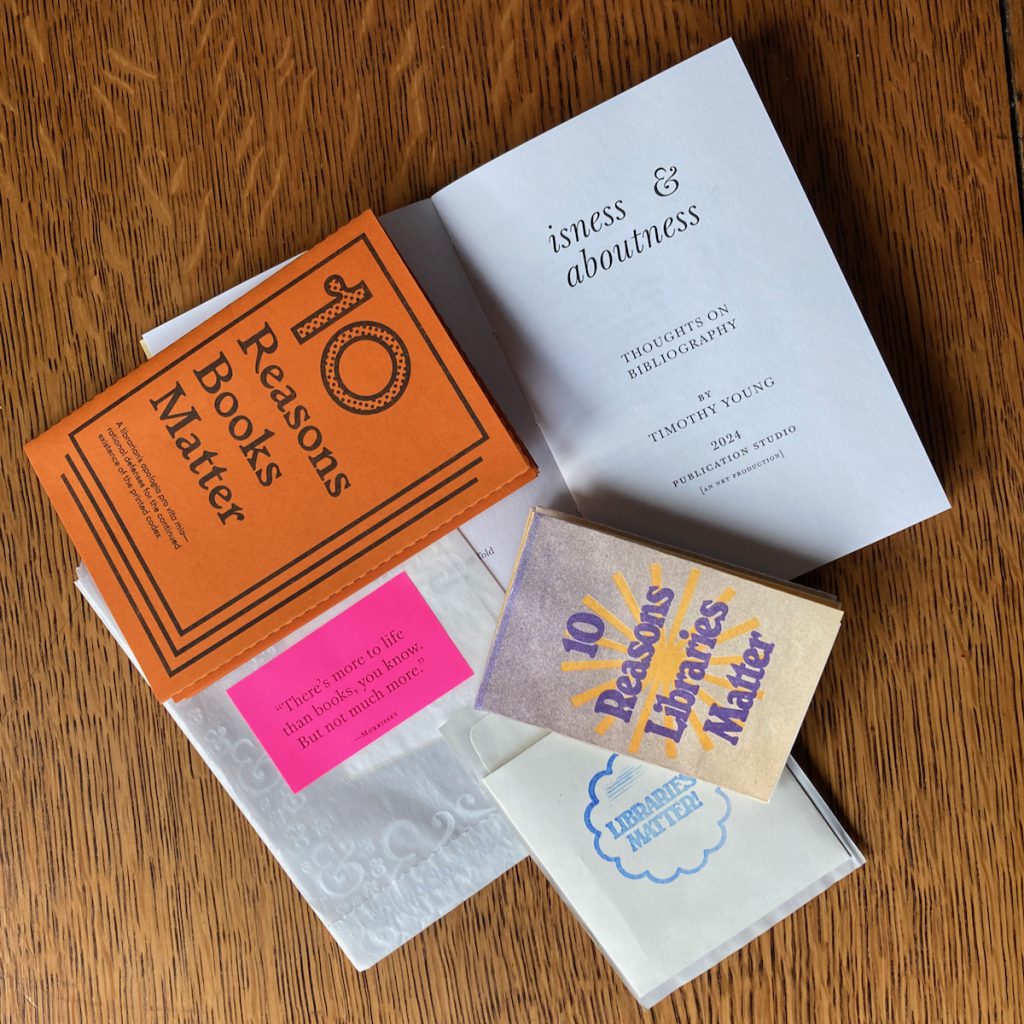
— Timothy Young. Isness & Aboutness. Thoughts on Bibliography. Publication Studio, 2024.
With two single sheet ’zines, printed rectos only :
— 10 Reasons Libraries Matter, 2021.
— 10 Reasons Books Matter, [2015].
Isness & Aboutness is a really great essay on thinking about books and thinking about the world (it is the text of Tim’s Sandars lecture at Cambridge University in November). He cites Donald McKenzie to good effect, on bibliography as
the only discipline which has consistently studied the composition, formal design, and transmission of texts by writers, printers, and publishers; their distribution through different communities by wholesalers, retailers, and teachers; their collection and classification by librarians; their meaning for, and — I must add — their creative regeneration by, readers [. . .] no part of that series of human and institutional interactions is alien to bibliography
His essay moves beyond McKenzie’s assertion to identify new modes of bibliography and to assert the primacy of bibliography as a means of uncovering what books are and what they do in the world. Highly recommended.
— — —
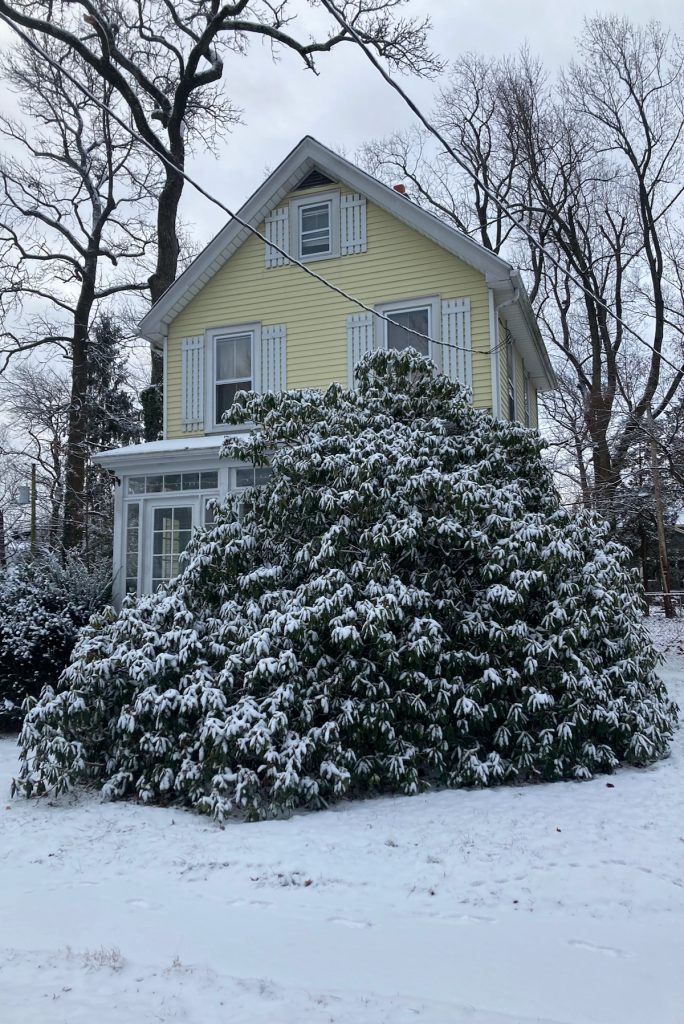
snow day, 11 January 2025
— — —
great blue heron flying low over the silvered mere
alighting on the ice beside a stand of reeds
in the distance, the pulaski skyway
/ from the train window this morning [16 January]
/ file under : extreme commute
— — —
ROUND-UP OF BOOKS FROM 2024 WORTH LOOKING FOR
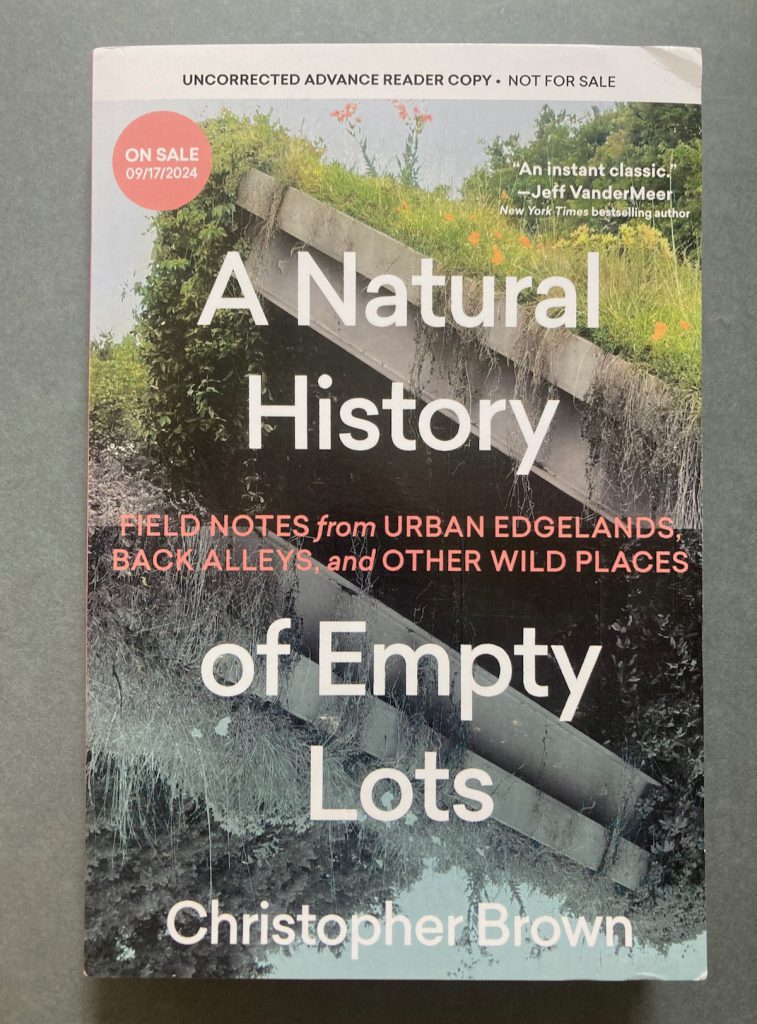
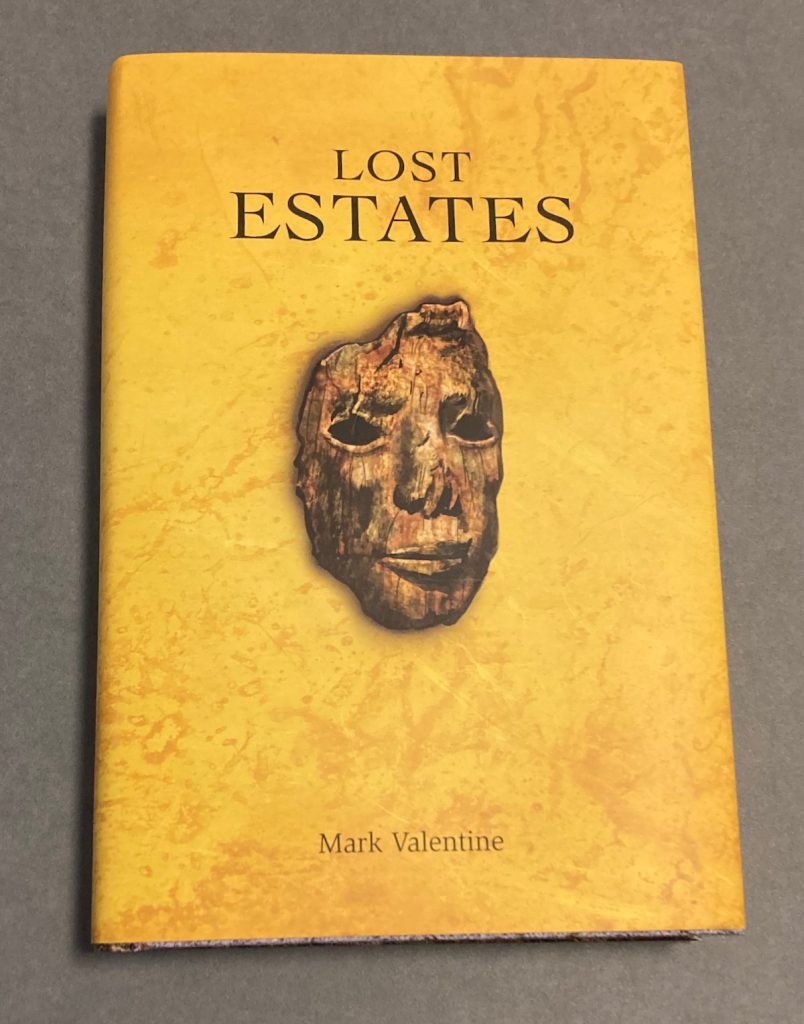
Collection of a dozen stories, four unpublished, including the excellent title story.
Collection of twenty-nine essays and vignettes, including pieces on Arthur Machen, A. J. A. Symons, M. R. James, and lesser known figures from the “curious alleys and byways” of literature and folklore. Fifth volume in his series of collected essays.
Collection of poems.
— John Clute. The Book Blinders. Annals of Vandalism at the British Library : A Necrology. Illustrated. Norstrilia Press, [2024].
I wrote a notice, here :
https://endlessbookshelf.net/2024/03/24/the-book-blinders-by-john-clute/
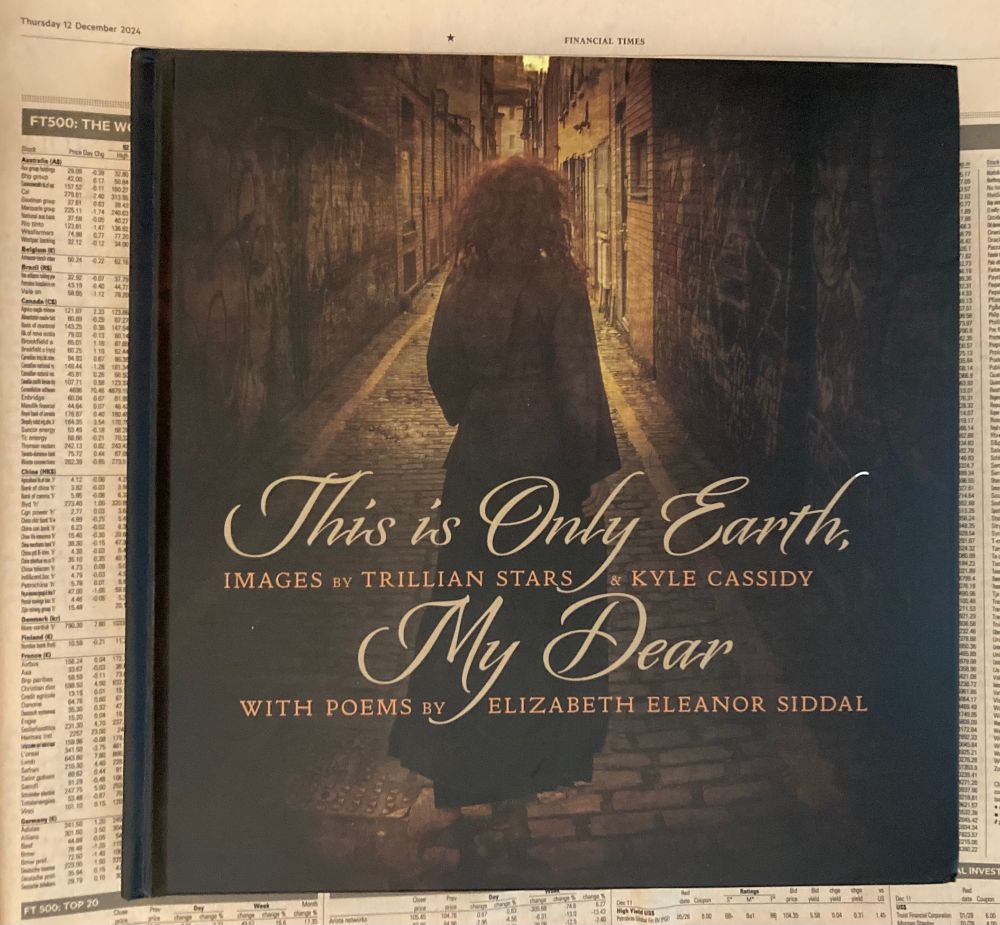
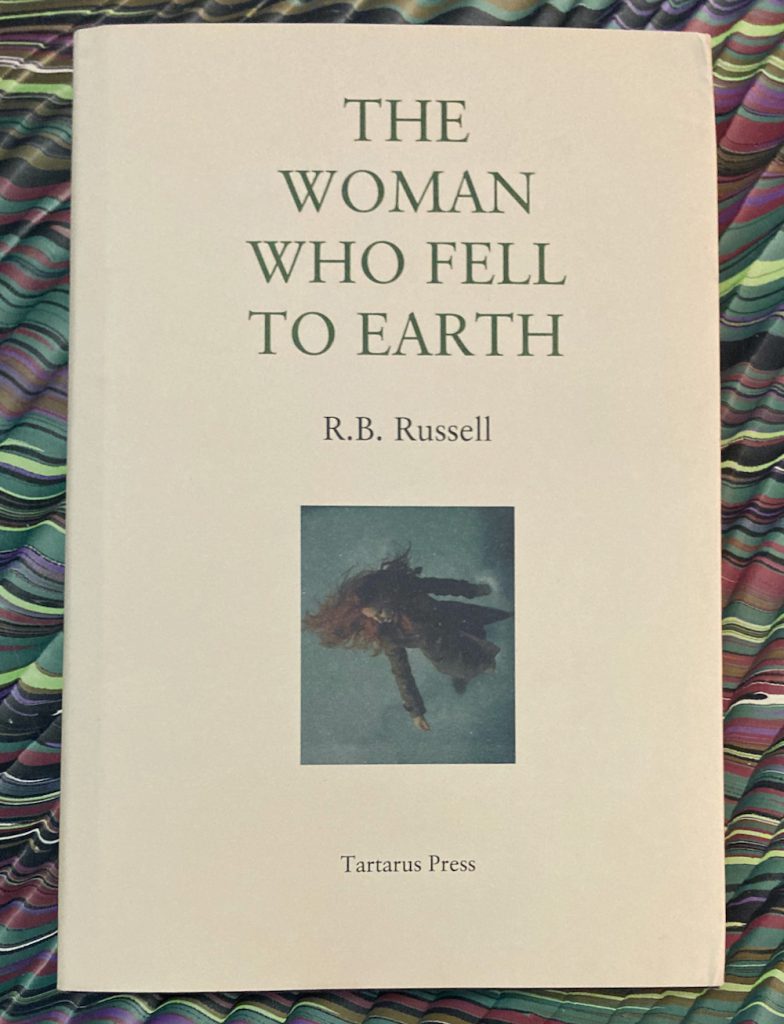
A wild short novel of doublings, tricks of memory, serious ontological ambiguities, and the perils of close involvement in the life and writings of a neglected author. Tanya and Caroline were friends from university days, though Caroline had become reclusive after her husband’s death. Caroline, literary executor of one hit wonder and horror novelist Cyril Heldman, had resurrected his name and formed an online community of readers (we see a bit too much of the hostile behavior that such small stakes games can provoke). Caroline gets back in Tanya’s life when she lands on Tanya’s roof: a corpse fallen from the empty sky. At the heart of the novel is and a house in Wales where time stands still, and the the Sixtystone, the object from Arthur Machen’s “Novel of the Black Seal”, which confers dangerous powers upon those in proximity. The resolution is deeply shocking, sudden and unexpected and seamlessly integrated into the narrative, even if some of the interesting implications are not fully explored. The ending is restorative and curiously cozy, almost pastoral.
2024 is the centenary of Melville’s Billy Budd, and there have been many phases in the year-long celebration. The catalogue of the Grolier Club show is well worth looking for. I was delighted to be a panelist on the symposium organized in connection with the exhibition. These events prompted me to publish A Melville Census, a bibliographical work looking at the last two books published in Melville’s lifetime : https://temporary-culture.com/product/henry-wessells-melville-census/#310899
It also prompted me to go back to primary sources, and and so on a recent visit to the Lilly Library I re-read John Marr, a book of ghosts and roll-call of the dead. The whole book speaks to Billy Budd, especially the quip of Captain Turret, “submission is enough”. De Vere was not so sensible an officer. There are other things I noticed which will require more time to contemplate ; these thoughts will show up in an essay sometime.

